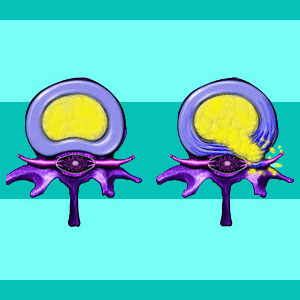
A fragmented herniated disc is a type of sequestration in which many small fragments migrate away from the damaged disc structure. These clinical profiles typically occur due to massive spontaneous trauma to the disc, facilitating a virtual explosion of the nucleus pulposus out of the destroyed annulus fibrosus. A fragmented disc will feel no pain in itself, since the intervertebral disc structure contains no neurological tissue. However, the fragments of the disc which migrate may cause symptoms through spinal stenosis, foraminal stenosis or chemical radiculitis in rare instances.
This treatise explains fragmentation of a ruptured intervertebral disc and the effects these pieces might enact on the surrounding spinal anatomy.
Fragmented Disc Symptoms
Many fragmented discs break into small pieces which are easily absorbed by the body, although this will take some time.
Chemical radiculitis is a very real concern for some patients with ultra-sensitized nerve tissue which comes in contact with these pieces of nucleus pulposus proteins. Remember, the chemical composition of this material is thought to be an irritant to nerve tissue, since it contains the substance known as tumor necrosis factor-alpha.
Spinal stenosis is highly unlikely to occur in symptomatic degrees, unless at least one fragment is quite large and pressurized enough to apply force to the spinal cord. This process may also occur if the remaining disc body itself is the main force applying the pressure and the fragments are incidental. However, if stenosis already exists, than an intervertebral rupture may exacerbate the problem.
Foraminal stenosis is slightly more likely to create symptoms, but this is still a rare event, even though foraminal narrowing is often incorrectly blamed for enacting expressions in the arms or legs. However, a disc fragment can block the neuroforaminal space and compress a nerve root in some patients.
Fragmented Herniated Disc Diagnosis
Small fragments might not even show up on detailed imaging, such as MRI, although larger fragments certainly will. Tracking the various pieces of fragmented disc may prove difficult, as they tend to move about and may be absorbed organically over time.
If surgery is being considered, a new MRI scan should always be performed immediately prior to the operation to facilitate finding the irritating fragments easily. After all, there is a good chance they may have migrated since the original scan was done.
It is crucial to know that statistically, fragmented discs are no more problematic or harmful than regular intact bulging discs. In fact, some problematic bulges actually resolve if the disc pressure becomes too great, forcing the disc to rupture and fragment. In some of these scenarios, the patient actually feels much better if the original bulge was exerting force against a nerve structure and this pressure ceases once the rupture occurs.
Many herniated discs are blamed for causing pain when all along they are coincidental to any symptoms experienced. This is especially true after time passes and the actual anatomical damage from an injury has had a chance to heal.
Fragmented Herniated Disc Diagnosis
Fragmented, sequestered, slipped, prolapsed, bulging, herniated, protruded, ruptured, torn and ripped are words often used to describe disc pathologies. There are so many descriptive phrases, since herniated discs are so incredibly common.
Most disc irregularities are nothing to fear, although it is crucial to learn the facts about herniated discs in order to dispel the considerable nocebo effect of the diagnostic process. This psychoemotional influence of the diagnosis can worsen, perpetuate or even source symptoms in patients without any justifiable anatomical causation.
It should be noted that for patients with severe chemical radiculitis sensitivities, successfully cleaning out a badly ruptured and fragmented disc surgically may be very difficult. Luckily, most patients will find relief with the simple passage of time, as the irritating proteins are neutralized naturally by the body over months or years.
Herniated Disc > What is a Herniated Disc > Fragmented Herniated Disc





